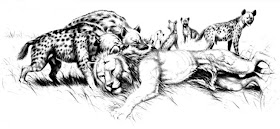Abstract
Bone remains and a trackway of Pantheraichnus bottropensis nov. ichg. ichnsp. of the Late Pleistocene lion Panthera leo spelaea (Goldfuss, 1810) have been recovered from Bottrop and other open air sites in northern Germany. Some of these bones are from open air hyena den sites. A relative high proportion of lion bones (20%) exhibit bite, chew or nibble marks, or bone crushing and nibbling caused by a large carnivore. Repeated patterns of similar bone damage have been compared to bone remains found at hyena dens in gypsum karst areas and cave sites in northern Germany. Ice Age spotted hyenas have been the main antagonists and the main scavengers on lion carcasses. The remains appear to have been imported often by hyenas into their communal dens, supporting the theory of strong hyena-lion antagonism, similar to the well documented antagonism between modern African lions and spotted hyenas. Most of the lion bones from the open air hyena den at Bottrop are probably a result of such antagonism, as are the rare remains of these carnivores found within large hyena prey bone accumulations along the Pleistocene rivers. The Emscher River terrace also has the largest quantity of hyena remains from open air river terrace sites in northern Germany. Their cub remains, and incomplete chewed prey bones from mammoths and woolly rhinoceroses, typical of hyena activity, underline the character of these sites as cub-raising and communal dens, where their prey was accumulated along the riverbanks in a similar manner to modern African hyenas.
Keywords: Panthera leo spelaea; Open air sites; Northern Germany; Late Pleistocene; Bone taphonomy; Palaeoecology; Biogeography
 |
| Spotted hyenas scavenge a lion carcass at an open-air, grassland site in Pleistocene Europe. Image by G. “Rinaldino” Teichmann and from Diedrich, 2011. |
Diedrich, C. 2011. Late Pleistocene steppe lion Panthera leo spelaea (Goldfuss, 1810) footprints and bone records from open air sites in northern Germany – Evidence of hyena-lion antagonism and scavenging in Europe. Quaternary Science Reviews. 30 (15-16), 1883-1906. DOI: 10.1016/j.quascirev.2011.03.006
Lions vs. Hyenas -- A Long-Running, Pleistocene Rivalry
